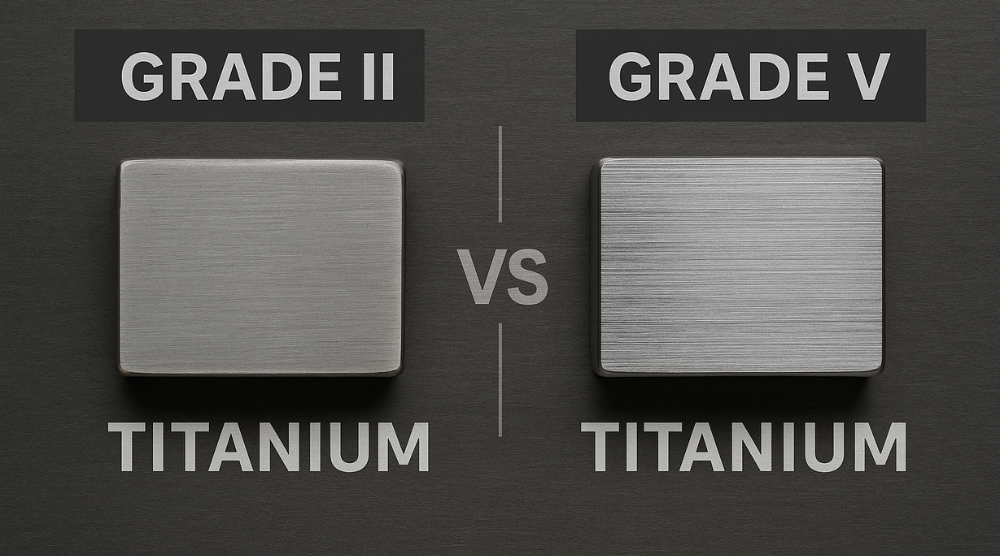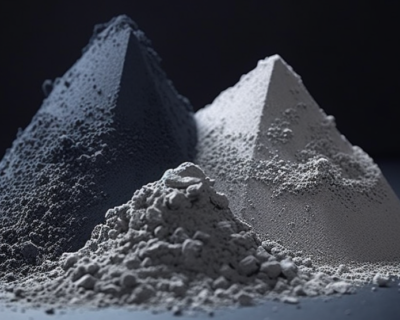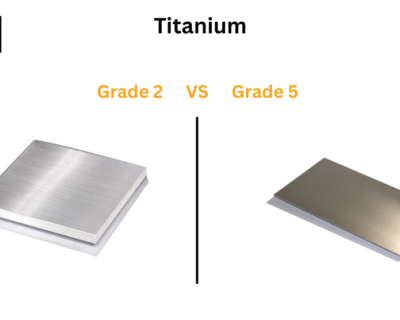Blogs

Grade II vs Grade V Titanium: Choose Wisely for Your Project
Titanium Grade II vs Titanium Grade V offer distinct differences in chemical composition, mechanical and electrical properties, corrosion resistance, and applications. Grade II is commercially pure with excellent corrosion resistance and good ductility, while Grade V is an alloy with aluminum and vanadium, providing high strength and thermal stability for demanding environments.
Chemical Compositions
- Grade II: ≥99.2% titanium, with minor oxygen (≤0.25%), iron (≤0.30%), carbon (≤0.08%), nitrogen, and hydrogen impurities.
- Grade V (Ti-6Al-4V): Approximately 90% titanium, with 5.5–6.75% aluminum, 3.5–4.5% vanadium, and small amounts of oxygen, iron, carbon, and nitrogen.
Mechanical Properties
- Grade II offers moderate tensile strength (345–550 MPa), yield strength (275–483 MPa), high elongation (20–30%), and excellent ductility.
- Grade V has much higher tensile strength (895–930 MPa), yield strength (828–869 MPa), but lower elongation (10–15%) and higher hardness (36–41 HRC), making it suitable for high-stress applications.
- Fatigue strength is higher in Grade V (~500 MPa) compared to Grade II (~300 MPa).
Conductivity and Electrical Properties
- Thermal conductivity: Grade II around 16 W/m·K; Grade V lower at about 6.7 W/m·K due to alloying.
- Electrical conductivity: Grade II approximately 1.8–3% IACS; Grade V lower around 0.6–1.2% IACS.
Corrosion Resistance
- Grade II excels in corrosion resistance, especially in corrosive environments such as marine and chemical processing.
- Grade V maintains good corrosion resistance but is somewhat less resistant than Grade II due to alloying elements.
Applications
- Grade II is used in chemical processing equipment (reactors, heat exchangers, piping), marine components, medical devices like surgical instruments and implants, environmental protection, and everyday items requiring corrosion resistance and good formability.
- Grade V is favored for aerospace structural parts, high-performance automotive components, military applications, medical implants requiring high strength, and precision manufacturing due to its superior mechanical properties and strength-to-weight ratio.
Maintenance and Life Cycle
- Grade II requires less maintenance due to its higher corrosion resistance and easier weldability.
- Grade V demands careful maintenance in corrosive environments but excels in durability and longevity under high mechanical stress.
- Both grades offer long life cycles, but Grade V stands out for high-performance demanding applications where strength is critical.
Choosing between Titanium Grade II and Grade V depends on application requirements prioritizing corrosion resistance, strength, thermal stability, and cost-efficiency. Grade II suits corrosion-heavy, easy-to-process uses, while Grade V meets the needs of high-strength, high-performance industrial and medical fields.
Choosing the right titanium grade defines the performance and reliability of your project.
For expert guidance and high-quality materials, connect with DOMADIA™—your trusted partner in advanced titanium solutions.
DM us or Visit DOMADIA™ to get the perfect grade for your application.
Talk to: Er.Pankaj Domadia | Kairav Domadia | Aadil Domadia | Pragati Sanap | Pooja N N
#TitaniumComparison #Grade2VsGrade5 #TitaniumAlloys #MetalsMatter #MaterialScience #TitaniumStrength #EngineeringMaterials #CorrosionResistance #HighPerformanceMetals #IndustrialMaterials #MetalProperties #TitaniumApplications #FutureOfMetals #MaterialSelection #EngineeringInnovation
Directly whatsapp us for an Enquiry: https://wa.link/kairav




